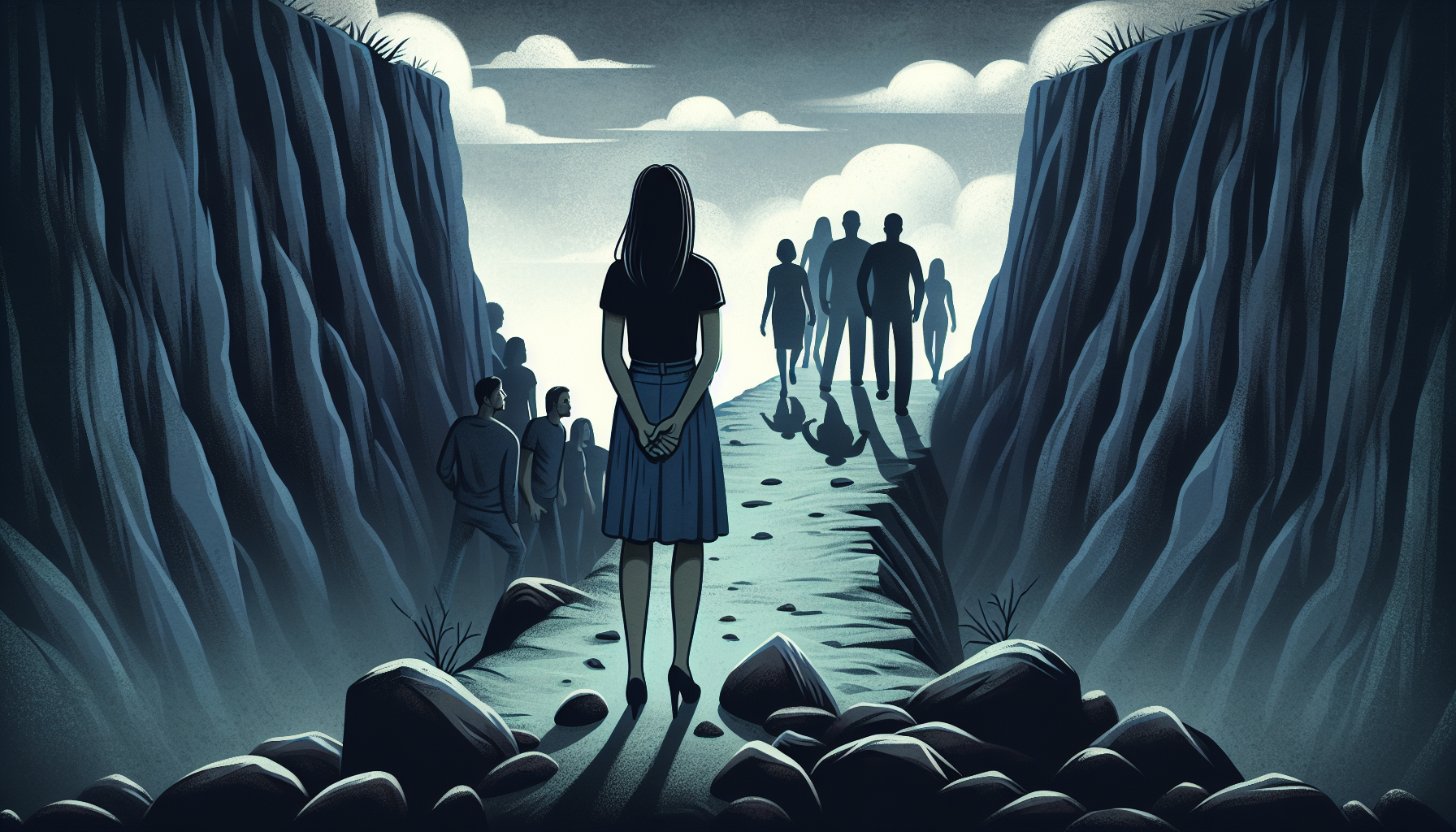If you’re often seeking guidance and hesitation marks your decisions, you might be experiencing a dependence schema. Understanding the dependence schema is key to recognizing how it can lead to an over-reliance on others, and affect your daily life and relationships. In this article, we address the hidden influences of the dependence schema, explore its effects on your rapport with others, and introduce steps towards cultivating independence without oversharing or overpromising.
Key Takeaways
- Understanding the dependence schema allows individuals to recognize their own patterns of over-reliance on others for decision-making and self-validation, which can hinder personal growth and autonomy.
- The dependence schema can significantly affect various types of relationships, including intimate partnerships, family dynamics, and friendships, often leading to codependency and strained interactions.
- Overcoming the dependence schema involves building confidence, fostering self-sufficiency, and engaging in schema therapy, which can lead to healthier, more balanced relationships and an improved sense of self-reliance.
The Dependence Schema: An Overview
Unnoticed often, the dependence schema is a mental framework that significantly influences individuals’ perceptions and behaviors. At its core, it embodies a belief of personal incompetence, leading to a deep distrust in one’s own judgment. To cope with this lack of trust, individuals may either overly rely on others or become overly self-reliant, refusing to ask for help. This schema is more than just a tendency to depend on others or oneself; it’s a lens through which individuals view themselves and their capabilities, often distorting reality and hindering personal growth.
The impact of the dependence schema extends beyond the individual, affecting a plethora of everyday decisions and interactions. From the seemingly inconsequential choices to life-altering decisions, the dependence schema can turn the act of choosing into an insurmountable hurdle. The repercussions of this schema are vast, touching on the fabric of everyday life and shaping the nature of our relationships with others.
Defining the Dependence Schema
Characterized by feelings of being overwhelmed and those who feel incapable, the dependence schema is often accompanied by a fear of abandonment and a desperate need for assistance. Those gripped by this schema are plagued by thoughts of incompetence and an excessive worry over losing their support systems, leading to panic when left to their own devices. It’s a self-fulfilling prophecy of inadequacy, where the lack of trust in one’s judgment becomes the very barrier to developing it. In some cases, this can be further exacerbated by the presence of an emotional deprivation schema, which intensifies the feelings of insecurity and dependence.
These core beliefs associated with the dependence schema—such as inadequacy, desperation, and panic—can make everyday situations feel like insurmountable challenges. The schema acts as a silent saboteur, undermining the individual’s confidence and reinforcing their dependency on others. It’s a complex and distressing cycle that can trap a person in a state of helplessness, often without their conscious awareness. In some cases, this may even lead to the development of a self sacrifice schema, where the individual prioritizes the needs of others above their own.
Origins of the Dependence Schema
To unravel the dependence schema’s grip on someone’s life, it’s essential to understand its roots. Often, the schema’s development is tied to parenting approaches, such as overprotective or authoritarian styles, which restrict a child’s autonomy and emotional growth. These methods of upbringing, coupled with environmental factors and potential genetic predispositions, set the stage for a child to develop dependency tendencies.
Traumatic experiences, especially those involving primary caregivers, can significantly contribute to a sense of incompetence and an entrenched dependency. When a child is subjected to over-criticism, lacks guidance, or faces excessive protectionism after an illness, they may shy away from independent decision-making out of fear of failure or criticism. These early experiences sow the seeds of the dependence schema, which can flourish into adulthood if left unaddressed in such children.
The Impact of the Dependence Schema on Everyday Life
Experiencing daily life with a dependence schema is much like traversing a minefield. The decision-making challenges are significant, leaving those affected feeling adrift and incapable of functioning independently. This often manifests as a fear of failure and humiliation, creating an aversion to even considering to tackle everyday tasks, which only compounds the struggle. The result is a habitual avoidance of anxiety-inducing tasks, culminating in a cycle of increasing stress as these responsibilities accumulate.
Influencing more than just task management, the dependence schema also molds self-concept. Individuals may come to rely heavily on others for validation, leading to a distrust of their own judgments and preferences. The overwhelming responsibilities of adult life, such as managing finances or maintaining health, can trigger intense dread, fear, and panic that appear insurmountable. These individuals often exude a childlike or vulnerable demeanor, signaling their distress and inability to navigate everyday problems without assistance.
Decision-Making Challenges
For individuals with a dependence schema, decision-making often becomes so daunting that it’s completely avoided. The perceived lack of adult competencies drives individuals to defer decisions to others, affecting their sense of personal agency and contributing to an undeveloped sense of self-reliance. This avoidance strategy can extend to friendships, where the constant need for reassurance and help with tasks burdens the relationship and hampers the individual’s growth. By not exercising their own judgement, they become more reliant on others for decision-making.
The avoidance of decisions is not just a matter of preference; it’s a deeply ingrained pattern of behavior that stems from the fear of making mistakes. This fear can paralyze individuals, making even the most mundane tasks seem daunting. The dependence schema instills a belief that one task done wrong can lead to serious repercussions, causing individuals to shy away from making decisions and taking on new tasks, including those that may seem easy to others.
Struggles with Self-Esteem
Undermining self-esteem significantly, the dependence schema fosters a belief in one’s own inadequacy that persists. This negative self-schema often remains deeply rooted, regardless of external achievements or assertions of independence. Consequently, individuals may experience the following:
- Downplay their successes
- Magnify their failures
- Reluctance to embrace independence
- Tendency to feel inadequate even when evidence suggests otherwise.
This struggle can also give rise to intense feelings of resentment, particularly when individuals become aware of their dependence and the role they play in perpetuating it. The internal conflict between a desire for autonomy and a sense of helplessness can trigger:
- panic attacks
- physical symptoms of anxiety
- feelings of guilt
- worry about being perceived as incapable or a failure
These negative emotional responses compound the difficulties in trusting oneself and exacerbate the many negative consequences associated with independence, including serious rejection.
Relationships and the Dependence Schema
Creating a complex web of dynamics, the dependence schema intertwines with relationships in ways that can be both supportive and detrimental. In intimate relationships, the codependency that emerges can provide temporary relief but also entrench feelings of inadequacy. Despite the security and care offered by partners, individuals with a dependence schema may experience resentment or anger towards them, as these relationships often amplify their own perceived shortcomings. Understanding the dependency schema can help individuals navigate these complex dynamics and foster healthier connections.
The introduction of schema therapy into the equation can offer a pathway to healthier relationships. Through role-playing and assertiveness exercises, individuals can practice independence within a secure setting, thereby improving the quality of their interactions with partners and family members. By addressing the underlying schema, therapy can help break the cycle of dependency and open the door to more balanced and fulfilling relationships.
Intimate Relationships
Intimate relationships often become a stage for the deepest vulnerabilities of those who navigate life with a dependence schema. Attracted to partners who can fulfill a need for dominance and protection, individuals reinforce their own feelings of incompetence and reliance, which can lead to intensely dependent behaviors. This dynamic can be difficult to escape, as dependence schemas influence expectations and interactions within romantic partnerships, often leading to patterns that create significant relationship challenges.
The coping behaviors that stem from an early dependence schema, like seeking excessive closeness or projecting an inflated sense of independence, can persist into adulthood. They can aggravate dependency issues within an intimate relationship, leading to a rigid reaction to internalized beliefs and potentially harming the relationship. This can manifest in failing to communicate needs effectively or placing undue demands on partners.
Family Dynamics
In the context of the family unit, the dependence schema often manifests as overt helplessness, resulting in feelings of being unable to cope and a sense that something crucial was missed during developmental years. This perceived helplessness can generate resentment towards family members who may unwittingly reinforce the individual’s dependence, leaving them feeling trapped and incapable of breaking free from this pattern.
The resentment towards family members may stem from the belief that they have contributed to or enabled the individual’s dependent behaviors. This dynamic can create tension and conflict within the family, as members may struggle with providing the right level of support while also encouraging independence.
Individuals with a dependence schema may feel as though they are burdened with all the details of life, such as managing financial records, without enough guidance or support from their family members.
Friendships and Social Support
Even friendships and social support networks can be affected by the dependence schema. Individuals with this schema may experience:
- Doubt and indecision, causing them to hesitate in initiating social plans or contributing to group activities
- Excessive reliance on feedback from friends, due to a lack of trust in their own judgment
- Strained relationships, as it can lead to feelings of vulnerability and inferiority
The dependence schema can lead to a range of behaviors in friendships, including:
- Clinginess
- Social avoidance
- Constantly seeking reassurance
- Withdrawing from social interactions
- Gravitating towards confident and competent friends
This dynamic can put the individual in a vulnerable position, reinforcing feelings of incompetence and reliance on others for approval and validation.
Coping Strategies for Overcoming the Dependence Schema
A multifaceted approach, addressing the underlying beliefs and behaviors, is required to overcome the dependence schema. A key part of this process involves managing daily tasks independently, which can help reduce the reliance on others. Positive affirmations play a crucial role in reinforcing one’s ability to function independently, building self-efficacy and challenging the persistent belief in the need for constant assistance.
Another important strategy is to create a support network that encourages self-reliance while avoiding enabling dependent behaviors. Here are some steps to follow:
- Take on decisions and tasks that have been previously avoided.
- Start with simpler tasks and gradually work up to more complex ones.
- Challenge yourself and build confidence in your abilities.
By following these steps, you can gradually become more self-reliant and confident.
Cultivating a sense of independence through problem-solving and recognizing successes can significantly contribute to overcoming the dependence schema.
Schema Therapy
Addressing negative self-beliefs and fostering confidence through new experiences, schema therapy is a powerful tool that helps individuals gain independence and control over their lives. Techniques such as ‘reparenting’, where individuals learn to internalize a nurturing voice, can be instrumental in encouraging self-reliance. Cognitive reframing helps transform negative self-concepts into a more positive self-image, which is critical for breaking free from the dependence schema.
The therapy also focuses on:
- Building confidence and competence by exposing individuals to new experiences
- Teaching them how to deal with negative outcomes autonomously
- Understanding the triggers of their dependence
- Cultivating new behaviors based on their values
Schema therapy assists individuals in forming healthier romantic relationships and improving their overall quality of life.
Building Confidence and Self-Sufficiency
Building confidence and self-sufficiency involves crucial steps like:
- Cultivating self-reliance
- Setting specific goals
- Recognizing and being proud of past accomplishments
- Overcoming obstacles and failures
- Evaluating the impact of goals on relationships and decision-making
By following these steps, individuals can build inner confidence and work towards personal development and continuous improvement.
Adopting a continuous learning approach to realistically assess and develop the skillset needed to support personal goals enhances self-reliance. Here are some steps to follow:
- Identify personal strengths and weaknesses honestly.
- Develop a plan to strengthen them.
- Foster a growth mindset, which is essential for building confidence.
- Know oneself, including understanding preferences and abilities.
- Don’t let them be overshadowed by external expectations or pressures.
By following these steps, you can enhance your self-reliance and achieve your personal goals.
Real-Life Examples of the Dependence Schema
The struggles and triumphs associated with the dependence schema can be better understood through real-life examples. A case study from the Netherlands involved a 63-year-old nursing home resident with multiple disorders who underwent schema therapy. Over the course of 27 months, the individual experienced significant improvements in early maladaptive schemas and reduced dysfunctional schema modes, leading to an enhanced quality of life.
The schema therapy was tailored to accommodate the patient’s cognitive impairments, using experiential techniques and visual aids to adapt to his abilities. This case study demonstrates that personality change is possible in old age and even with cognitive decline, suggesting that schema therapy can be a feasible treatment for older adults with personality disorders and cognitive impairments in a nursing home setting.
Summary
Throughout this exploration, we’ve uncovered the pervasive nature of the dependence schema and the profound impact it can have on individuals’ lives and relationships. From the origins of the schema in childhood to the daily challenges it imposes, the dependence schema can be a formidable obstacle to personal growth and independence. However, as we’ve seen, with the right strategies and support, overcoming this schema is not only possible but can lead to a more autonomous and fulfilling life.
As we conclude, let us take these insights and be inspired to foster resilience and self-reliance in ourselves and those around us. The journey toward overcoming the dependence schema is one of courage and determination, but it’s a journey that promises a rewarding destination: the freedom to trust in one’s capabilities and the strength to forge one’s path.
Frequently Asked Questions
What causes dependence schema?
The dependence/incompetence schema is typically caused by overly protective caregivers, especially in cases where a child has experienced a major injury or serious illness. This over-protectiveness can contribute to the development of this schema.
What are the 5 basic needs of schema therapy?
The 5 basic needs of schema therapy are connection, mutuality, reciprocity, flow, and autonomy. When these needs are not met, unhealthy life patterns can develop.
How does the dependence schema affect decision-making?
The dependence schema can lead to significant anxiety around decision-making, causing individuals to feel unable to make competent choices on their own and leading to over-reliance on others for even minor decisions.
Can relationships actually improve if someone overcomes their dependence schema?
Yes, overcoming dependence schema can lead to healthier and more balanced relationships by allowing individuals to engage in relationships with greater independence and trust in their own judgment. This can result in improved dynamics and mutual respect.
Is it possible to overcome the dependence schema later in life, even with cognitive impairments?
Yes, it is possible to overcome the dependence schema later in life, even with cognitive impairments, as shown in a case study from the Netherlands. Older adults can experience improvements with adjusted schema therapy, leading to a better quality of life.























































